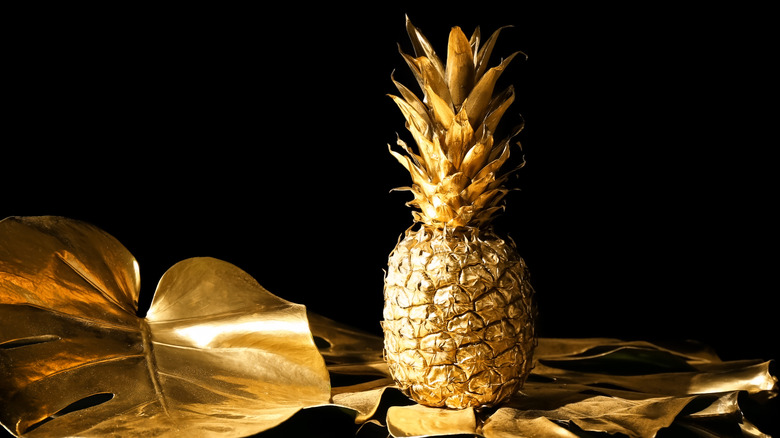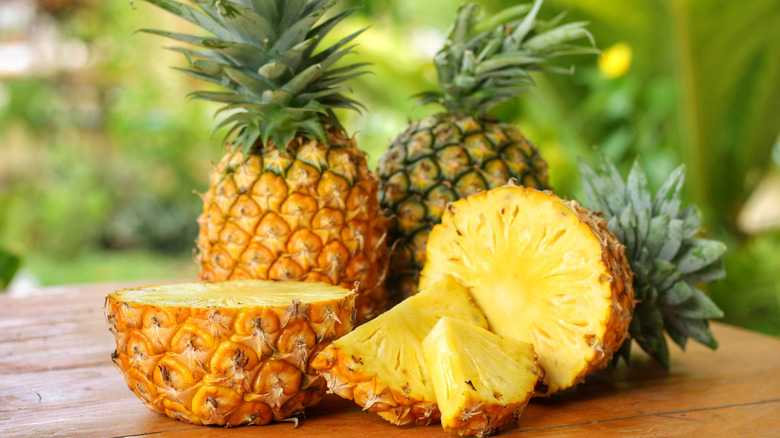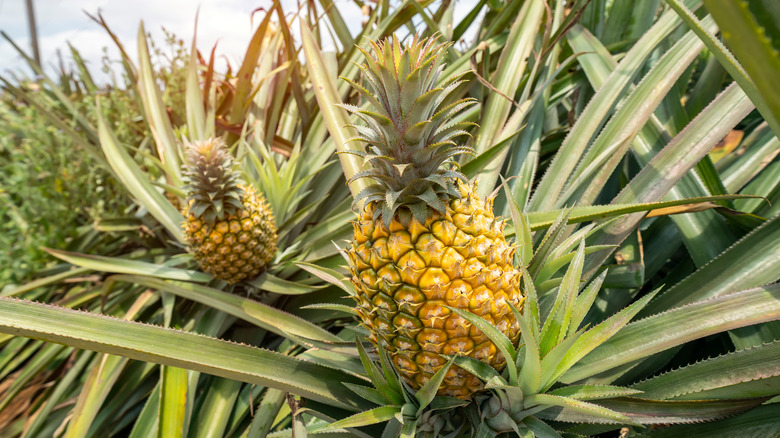Why Pineapples Were Once Valued At Over $8,000
Whether you like eating your pineapples raw, blended in a cocktail, or, most controversially, on top of your pizza, there's no denying that this juicy golden fruit is guaranteed to brighten up any meal.
While today pineapples can be easily found lining the produce aisle of any average grocery store, once upon a time these spiked fruits were considered a luxury that only the wealthiest could afford, fetching thousands of dollars for a single spiky fruit (via Mental Floss).
Historians believe that these sweet, mildly acidic fruits were first grown in the rainforests of Brazil and became a popular crop for native tribes throughout Central and South America, particularly on the island of Guadeloupe. It wasn't until Spanish explorers landed on Guadeloupe in the 15th century that the fruit began to spread throughout the world, first to Spain and then elsewhere in Europe, Asia, and Australia (via WDPI).
After Christopher Columbus brought the sweet, exotic fruit — which received the name 'piña' from the Spaniards, as a nod to its pinecone-like appearance, and later had 'apple' tacked on by the English — back to his homeland, pineapples became a popular delicacy among the European elites.
The imported tropical fruits became a symbol of high society
While these unique imported fruits were enormously popular, their long cross-Atlantic journey resulted in very few pineapples making it intact to Europe. A large portion of the imported pineapples arrived bruised or rotten, resulting in an extremely low supply despite a rapidly growing demand. Because of this, only the wealthiest members of society were able to afford one of these treasured fruits.
In an attempt to cash in on the pineapple's growing popularity, farmers across Europe, particularly in the UK, spent nearly two centuries trying to figure out how to grow the tropical fruits in a cold, unsuitable climate (via Historic UK).
Finally, in the 18th century, a handful of pineapple growers in England and the Netherlands constructed hothouses, which replicated the heat and humidity of the fruit's homeland, in order to produce European-grown pineapples (via Mental Floss). However, these hothouses were still few and far between, producing limited amounts of pineapples that could still only be afforded by monarchs and members of the upper echelons of society.
Throughout this period of history, pineapples became a symbol of extreme wealth, luxury, and decadence, so much so that pineapples were often incorporated into the design of buildings and architectural projects, like St. Paul's Cathedral in London (via Historic UK). King Charles II was such a fan of the pricy fruits that he had a royal portrait painted of himself receiving a treasured pineapple from the palace gardener.
A single pineapple could fetch thousands of dollars
This luxurious reputation spread to the American colonies, where the cost of pineapples was still sky-high despite being geographically closer to South America. The pineapples imported to the colonies from the Caribbean islands could fetch as much as $8,000 (in modern dollars) for a single fruit. Due to the lavish price tag and extreme rarity of the fruit, elites in Europe and the colonies occasionally threw pineapple-centric parties to celebrate the purchase of the fruit, during which the prized pineapple was passed around and used as a showy centerpiece (via Historic UK).
Others would bring their pineapple along to parties and events — not to share, but rather to show off as a symbol of high status. The fruit was such a lavish symbol of extreme wealth that it would typically be displayed, uneaten, in the buyer's home until it began to rot. Only then would the purchaser slice into the extremely ripe fruit.
The pineapple's highfalutin heyday slowly came to an end in the 18th century, when importing pineapples became more regulated and additional growers popped up around Europe and the United States. Then, at the start of 20th century, pineapple tycoon James Dole began growing the tropical fruits in mass on his Hawaii plantation, which eventually went on to produce up to 75% of the world's pineapples (via Dole). The Dole plantation exploded the worldwide pineapple population, causing pineapple prices to plummet once and for all.
Today, pineapples are one of the most plentiful fruits found around the globe, but evidence of the fruit's once-lofty reputation can still be spotted on the facades of palaces, cathedrals, and other landmarks across Europe and beyond.


